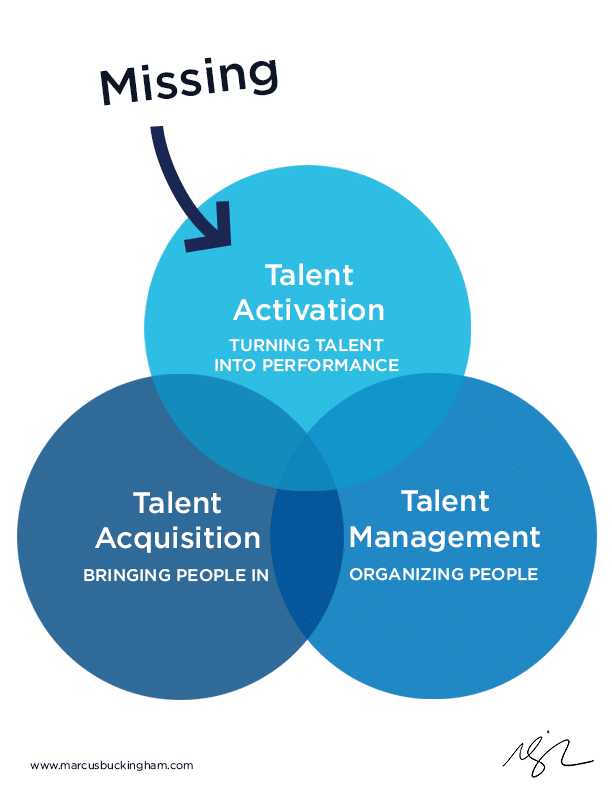We are familiar with the terms Talent Acquisition and Talent Management. Historically, human resources’ primary role was to build people initiatives that identified and acquired great talent. Then, the goal is to manage that talent, to align with organizational objectives and retain and develop talent.
What has been missing? Talent Activation.
Says Marcus Buckingham
In a dynamic and competitive market, talent can be a company’s competitive advantage. However, the skills and capabilities of employees are often underutilized. Marcus Buckingham noted that by activating talent, we “take human potential and turn it into contribution. It’s the challenge of taking one person’s talents and deliberately and effectively turning it into performance.”
What is Talent Activation?
Talent activation is the process of unlocking the full potential of your employees. Providing them with the necessary resources, tools, and support they need to excel in their roles. Therefore, it is a holistic approach to creating an integrated employee experience that aligns with the organization’s goals, culture, and customer experience.

Additionally, talent activation enables companies to tap into their employees’ current skills and expertise, thus empowering them to do their best work. In doing so, organizations remain agile and can pivot quickly to remain competitive. Lastly, talent activation also requires organizations to maintain a people-centered approach that values human contributions and invests in employee growth.
The Benefits of Talent Activation
Some of the benefits of creating a focus on Talent Activation are:
- Increased employee engagement and motivation
- Improved productivity and performance
- Enhanced innovation and creativity
- Higher retention rates and reduced turnover costs
- Better alignment between employee and organizational goals
- Increased customer satisfaction and loyalty
- Improved employer brand and reputation
6 Ideas to Start Building Your Talent Activiation Center of Excellence
(1) Create a Skills Inventory
The first place to start is to create an inventory of skills. Simply, send out a brief survey to understand current skills and proficiency levels. If you have an upcoming performance review cycle or career development discussion, think about adding this as a quick extra step. The exercise is a great place to start if you haven’t done career development discussions before. The survey results guide an employee and manager to clarify skill level, outline a desired future state, and finally, create a development plan.
There are some excellent technology platforms that you can use to maintain and keep this skills data updated over time. A Google sheet or Microsoft Excel document may suffice, just for simplicity.
(2) Mapping Your Employee Journey
To activate talent, organizations must understand how they interact with employees throughout their journey at the company. Specifically, the critical stages of the employee life cycle. From the moment a candidate reads a job description, interviews, and accepts an offer — then gets onboarded, promoted to the day they depart. Each critical stage has moments that matter most to your employees. How an organization supports and provides resources to employees in these moments results in their capacity to activate talent. The more support, the higher the percentage chance the organization is moving the needle to activate their talent.
(3) Transition Skills Data from Interview to Onboard
During the interview process, often skill-level data is collected but forgotten. The interview is an excellent datasource for managers and employees to help kick-start creating an onboarding and initial development plan. Employees can review the strengths and areas of opportunity found during the interview process. Thus, this additional data delivers a more holistic picture to managers. Together, they surface areas of opportunities and ultimately, make sure the right tools and resources are provided during the first 90 days. Therefore, creating the right employee experiences and learning to grow in these areas.
(4) Focus Employees on the Work that Matters
MeBeBot’s customer research indicates employees spend 30% of their workday searching for information. Of which, 60% of employees need more time understanding where to find the information required. Digital transformation helps optimize and create workforce efficiencies, resulting in greater employee productivity and satisfaction. Allowing employees to spend more time on the work they enjoy. Where do you start? Your employees doing the work probably have the best ideas on how and where to optimize. Managers can hold quarterly or monthly retrospectives and ideate ways to continue to become more efficient in their current processes and workflows.
(5) Provide Employees with a 24/7 Coach and Guide
Thoughtfully map out digital transformation needs to create a seamless and integrated organizational technology stack that is effortless for employees to use. If not done, employees quickly become lost and frustrated in the vast sea of workforce solutions. Have you considered getting each employee their own digital conversational AI chatbot? Available at any moment, a chatbot walks alongside your employees’ flow of work and points them to the right person, document, or technology tool. Like any good guide or coach, an AI intelligent assistant obtains feedback and directly delivers it right to the service delivery team for continuous improvement. Coaches also augment workplace training to reinforce learning and positive habit change — specifically through pulse surveys and tailored communication nudges.
(6) Goal Alignment and 1:1s
Let’s return to the basics. The reality is many managers and employees do not know how to create and communicate clear expectations. Companies may articulate their primary business priorities, but things often fall apart. Managers have difficulty breaking down key business priorities into department, team, and individual goals. Activation requires us to set clear targets and provide regular feedback on progress against those targets throughout the organization. 1:1’s, Team and Department Meetings, and the best opportunity to provide progress updates and course corrections on focus areas. Consequently, organizations that do this well have employees that come to work every day with clarity on how their work impacts the customer experience creating purpose. In conclusion, the data shows that organizations with a high employee purpose are more likely to keep and attract quality talent.
Schedule a demo today to learn how you can provide your employees with a new “digital front door” with MeBeBot’s AI Intelligent Assistant.

